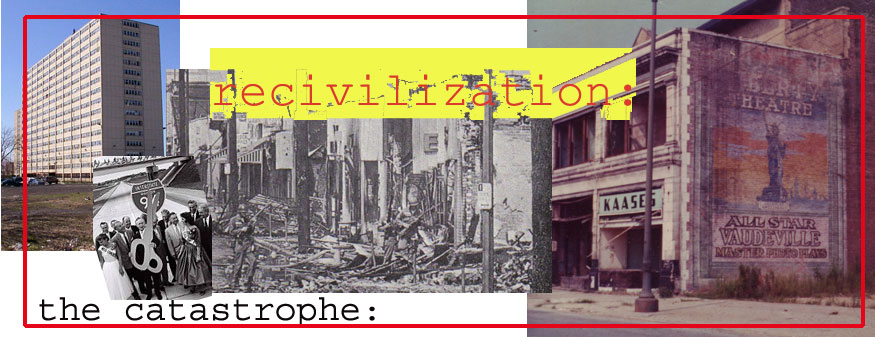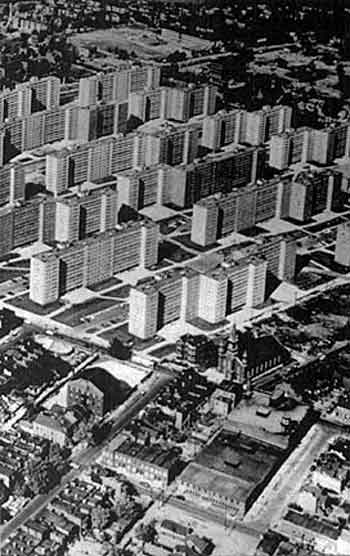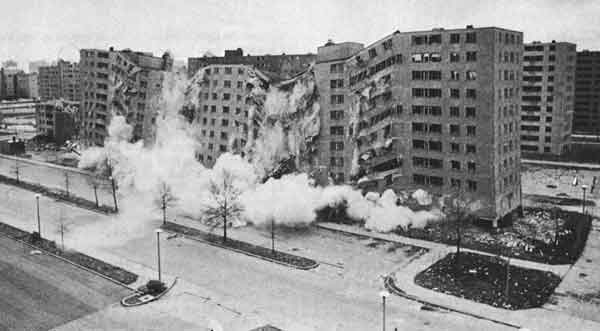

316 file cabinets for the poor
Pruitt-Igoe Homes, St. Louis, 1954
In Humphrey Bogart's last film, The Harder They Fall (1956), he played a sports reporter who went after the mob that was turning boxing into a corrupt joke. This may be the only film ever in which a project got a sympathetic role as backdrop. Bogie lived in New York's brand-new Stuyvesant Town, which despite a certain Modernist chill is still one of the least unpleasant projects around. Brick cruciform towers in a carefully landscaped superblock off Union Square, Stuyvesant Town was in fact middle class, co-op, whites-only housing, built by an insurance company for profit, with federal subsidies and tax breaks. Architects back then wanted all Americans to live a modern, socially useful life in such places. To many at the time, and probably to director Mark Robson, Stuyvesant Town was New York's future, a shining contrast with the ranks of tenements that surrounded it. It helped set up Bogie's character as a courageous progressive, somebody who was from the bad old city and understood it, but wasn't afraid to try and make it better. Many people, in Washington and in the cities, were trying too, and the 1949 and subsequent Housing Acts gave them the opportunity to take up the job the New Deal had started in creating social housing for the urban poor. The national showcase for postwar public housing was the Pruitt-Igoe project near downtown St. Louis. Twelve blocks of a struggling neighborhood had been razed for the work. Completed in 1954, Pruitt-Igoe consisted of 33 identical eleven-storey slabs containing 2,780 apartments. Planners and officials from all over the country came to learn from it, and its avant-garde rectilinear starkness won architect Minoru Yamasaki an architectural award. To most St. Louisans, it seemed a visitation dropped down from outer space. The lucky residents didn't seem to care much for it either. Almost from the beginning, Pruitt-Igoe was an unaccountable problem child, dogged by vandalism and crime. Years later, the problem would be dissected brilliantly in an influential little book called Defensible Space, by Oscar Newman Using the most impeccable social science methodology, Newman showed how the Modernists ignored some basic rules of how people in a community perceive and use the 'public' and 'private' space around them. Modernist slab buildings like Pruitt-Igoe's had only one entrance, and long corridors on each floor, leading to many doors. All this interior space that belongs to everyone in fact belongs to no one, and residents will not 'defend' it-watch over it and keep it safe and clean-the way they do in similar projects (like Stuyvesant Town) where only two or three families share an entrance. The same was true for the space between the towers, where the architect had naively assumed families would have picnics and send their children out to play. In every Modernist estate ever built, these 'undefended' spaces became uncomfortable no-man's lands, and in the worst cases they bred crime more efficiently than any dark alley. Newman neglected only one element, one that cannot be measured in studies: the ambience of unreality and despair that comes with living in such places, and drives normal people not only to give up on their own lives, but to will the destruction of the abominations in which they had been 'housed'. Add to that poor maintenance and policing from a bureaucratized housing authority, and Pruitt-Igoe's decay into a 'vertical slum', far more dangerous and dilapidated than the neighborhood it replaced, took only a few years. As a showcase, the project could not be allowed to fail. In the 60's HUD and local government poured millions into fixing it up, and they sent in an army of social workers to interrogate, prod and counsel the residents. These, unfortunately, were bailing out as fast as they could. By 1972 only the vicious and the desperate were left, in a project two-thirds empty. Social housing was not a uniquely American tragedy; the dynamiting of failed high-rise projects still provides frequent, telegenic filler on the news in Europe-and indeed, all over the world. The convergence of Modernism and technocracy was a worldwide phenomenon. It designed much of the world we live in; another century may not suffice to clear up all the shambles it made. America's particular problem was the intersection of this idealistic, doomed housing effort with the most pressing need felt by city elites in the 50's: the containment of blacks, including the large numbers displaced by highways and urban renewal. By that time, it had become clear to everyone but the most delusional administrators and planners that government project was going to mean Negro project. Planners and 'housers' were convinced of the rightness of big Modernist plans, and so found a strange community of interest with city leaders concerned with containing blacks. Chicago's respected CHA director Elizabeth Wood fought unsuccessfully to keep her agency from the clutches of the Daley machine, but like almost every other housing official she was a firm believer in really big projects. There, she and the Boss had something in common, and it was under Daley that the big monsters took shape: first the Henry Horner Homes in 1957, then Stateway Gardens, the first phase of Cabrini Green, followed in 1962 by the Taylor Homes, a row of 28 slabs picturesquely sited next to the Dan Ryan Expressway. Few cities built as badly as Chicago and St. Louis, but public housing everywhere was mired in problems from the start. The politicians who wrote the legislation had primarily been concerned with providing work for the building trades, and the projects were correspondingly expensive, far more so than those of the New Deal. Even though economy was part of the justification for high-rises, many of the 50's projects, like St. Louis's, cost the government as much per unit as privately-built luxury housing, despite shoddy building standards and lack of amenities. Projects immediately lowered the land values of their surroundings, while overburdening neighborhood services and infrastructure. In nearly every case, whatever promise and stability a neighborhood possessed ended when a major project was built. Living near one proved just as impossible as living in one. Somewhere in any American city, in a 50's urban renewal area, you can find a government project that was supposed to 'attract the middle class back to the city'. They're indistinguishable from the other projects in the area today, and you would have to dig hard to find the old news clippings and brochures that explain the planners' bold premise. Here is cutting-edge architecture, surrounded by greenery-surely such a project will lure sympathetic, progressive white people to the inner city. In fact, it was invariably a dismal barracks, set in the most desperate part of town. The idea scored a very few successes, as in Southwest Washington D.C., but in those cases it required the flattening of a vast area under urban renewal, and the removal of all the people in it. Through the 60's, the big projects decayed as fast as they were built, while tenants with the means to escape got out as fast as they could. Congress helped the process along, constantly reducing the size and quality of new apartments, and cutting maintenance budgets. The last nail in the coffin for public housing came with the Brooke Amendment to the 1969 Housing Act. This seemingly progressive step prevented authorities from charging more than 25% of a tenant's income for rent; unfortunately, Congress never came through with the money promised to make up the shortfall, so cash-strapped housing authorities around the nation had to cut back drastically on maintenance and services. Later on, Washington would force the local authorities to give preference on the waiting lists to the very poorest people. The probable results of such a policy might have seemed obvious, but in the looking-glass world of federal policymaking, where no one person has all the authority or takes all the blame, no one involved did anything but watch the end of the tragedy unfold. Across the country, already-troubled projects slipped rapidly into ruin. The worst of them, Pruitt-Igoe, was already doomed before the 1969 changes, and it made a stunning impression as Americans watched the first buildings implode on the TV news in July 1972. It meant the beginning of the end for Modernist architecture and all its impostures, and it marked a turning point in federal policy. Not long afterwards, President Nixon shut down the public housing program for good, along with urban renewal. The existing high-rises festered on throughout the 80's and 90's. For many, the crack epidemic was the last straw. Chicago's Taylor Homes, with its 20,000 residents, at one point accounted for 11% of all the city's murders and 10% of the aggravated assaults. Chicago is just about finished tearing it down. 
|
|

|